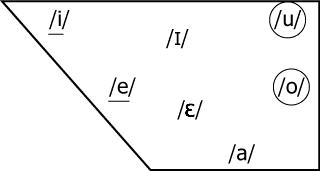| 3.7 | Problems |
Appendices
3.7 Problems
In transcribing the phones in these problems, you can replace the symbols that are not found on a keyboard with uppercase letters. (These conventions agree mostly with emerging internet conventions for representing IPA in email and newsgroups.)
- ɛ → E
- ɑ → A
- ɔ → O
- θ → T
- ð → D
- š → S
- ž → Z
- č → C
- ǰ → J
- ŋ → N
For "æ", use "&".
3.7.1 Vowels
-
The chart below shows the vowel phonemes of Amharic in vowel space. Rounded vowels are circled; spread vowels are underlined. Note that some of the symbols do not refer to exactly the same sounds that they refer to for English.

Describe each vowel in terms of its values on the relevant vowel dimensions. There should be three dimensions.
/i/ HEIGHT: HIGH, BACKNESS: FRONT, ROUNDING: SPREAD
/e/ HEIGHT: MID, BACKNESS: FRONT, ROUNDING: SPREAD
/u/ HEIGHT: HIGH, BACKNESS: BACK, ROUNDING: ROUND
/o/ HEIGHT: MID, BACKNESS: BACK, ROUNDING: ROUND
/ɪ/ HEIGHT: HIGH, BACKNESS: CENTRAL, ROUNDING: NONE
/ɛ/ HEIGHT: MID, BACKNESS: CENTRAL, ROUNDING: NONE
/a/ HEIGHT: LOW, BACKNESS: CENTRAL, ROUNDING: NONE
-
For each of the following English words, write the symbol for the vowel
in the word. Do not use a dictionary to help you.
- mine
/ay/
- main
/e/
- mean /i/
- moon /u/
- moan /o/
- men /ɛ/
- man /æ/
- love /ʌ/
- weird /ɪ/
- weigh /e/
- pants /æ/
- soft /ɔ/ or /ɑ/
- put /ʊ/
- owe /o/
- far /ɑ/
- loud /aw/
- point /ɔy/
- head /ɛ/
- niece /i/
- mine
3.7.2 English consonants
-
For each of the following sets of English phonemes, say which features
(dimension values) they share. For item j, you will have to come up
with a feature that is not mentioned in the book; think of what the
articulation of these phones shares, and describe it in a short sentence.
Example: /p, b/ — bilabial, stop- /ɛ, æ, ɪ, i, e/ front
- /ʊ, i, u, ɪ/ high
- /z, d, n, t, s/ alveolar
- /w, y/ semivowel (or approximant or sonorant)
- /n, ŋ, m/ nasal
- /v, z, ž/ fricative, voiced
- /g, ŋ/ velar, voiced
- /s, z/ fricative, alveolar
- /t, k, p/ stop, voiceless
- /p, m, f, b, v/ "labial" (involving one or more lip)
- /ɛ, æ, ɪ, i, e/
-
Transcribe each of the following English words, using the phonetic symbols in the book. Do not use a dictionary to help you.
- creature /'kricər/
- anger /'æŋgər/
- hanger /'hæŋər/
- luxury /'lʌgžəri/ or /'lʌkšəri/
- pushed /pʊšt/
- physics / 'fɪzɪks/
- badges /'bæǰəz/
- thistle /'θɪsəl/
- rhythm /'rɪðəm/
- choir /'kwayər/ or /kwayr/
- creature
3.7.3 Syllables
-
For each of the following, say whether it is a possible word in English (whether it obeys English phonotactics). If it is not possible, say why in the most
general terms possible.
Example: /læbg/ No, because English syllables cannot end with a /bg/ cluster.- /psu/
No, because English syllables can't begin with /ps/ or, more generally, with any consonant followed by a fricative.
- /plʊ/
No, because English syllables can't end with /ʊ/ or, more generally, with lax vowels (other than /ɔ/).
- /nawz/
Yes.
- /wrayn/
No. English syllables can't begin with /wr/ or, more generally, with /w/ followed by any other consonant.
- /brith/
No. English syllables can't end with /th/ or, more generally, with /h/.
- /bɪŋf/
No. English syllables can't end with /ŋf/ or, more generally, with /ŋ/ followed by a non-velar consonant.
- /sprʊks/
Yes.
- /'kræbəl/
Yes.
- /sædb/
No. English syllables can't end with /db/.
- /'pyuzi/
Yes.
- /psu/
